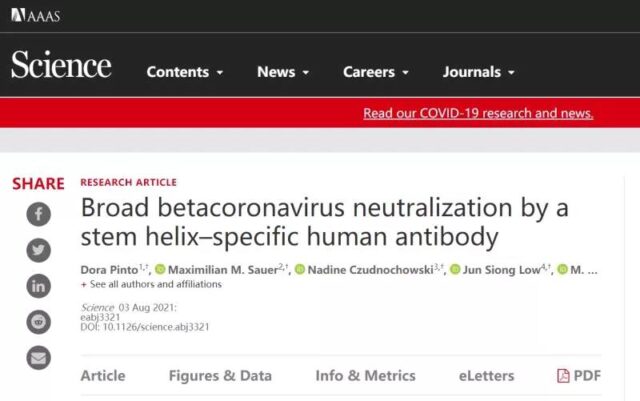UV found inspiration for developing vaccines from virus antibodies!
- Statins Lower Blood Lipids: How Long is a Course?
- Warning: Smartwatch Blood Sugar Measurement Deemed Dangerous
- Mifepristone: A Safe and Effective Abortion Option Amidst Controversy
- Asbestos Detected in Buildings Damaged in Ukraine: Analyzed by Japanese Company
- New Ocrevus Subcutaneous Injection Therapy Shows Promising Results in Multiple Sclerosis Treatmen
- Dutch Man Infected with COVID-19 for 613 Days Dies: Accumulating Over 50 Virus Mutations
breakthrough! University of Washington found inspiration for developing vaccines from virus antibodies!
UV found inspiration for developing vaccines from virus antibodies! Vaccines are one of the effective ways to protect humans from harmful pathogens. Recently, a group of scientists at the University of Washington found new inspiration for developing effective vaccines while studying antibodies.
In the past 20 years, three pandemic coronaviruses-SARS-CoV, MERS-CoV and SARS-CoV-2 have spilled from animals, causing deadly diseases in humans. To this end, virus researchers decided to find a way to broadly protect people from the ongoing threat of emerging coronaviruses.
The clue to the design of this strategy may come from a rare human antibody that can neutralize several different coronaviruses. Scientists have detected the presence of these antibodies in some survivors of COVID-19 pneumonia. The results of this research were published in an article titled “Broad betacoronavirus neutralization by a stem helix–specific human antibody” in the journal “Science” (Nature).

The article describes the research on these five types of human monoclonal antibodies, which can cross-react with some beta coronaviruses. These antibodies are directed against a structure in the spike protein of the virus called a stem helix. Spike proteins are critical to the ability of the virus to surpass the host line.
The main authors of this study are Dora Pinto, Maximian M.Sauer, Nadine Chuudnochowski and Jun Siong Low. The senior scientists of this research project are David Veesle, associate professor of biochemistry at the University of Washington School of Medicine in Seattle. During the evolution of certain coronaviruses, the stem helix in the S protein has remained stable. This means that it is not prone to genetic changes, and similar conditions exist in various other coronaviruses. These include those subgenus that originated from bats. The viruses carried by these bats have become pathogens that threaten human life. Another subgenus causes some serious human lung diseases. These types of lung diseases are transmitted through bone and spinal cord cells. There are also some subgenus that are prone to common cold symptoms.
The researchers explained in their paper that they are interested in exploring antibodies that target highly stable regions of the spike protein mechanism that enable coronaviruses to fuse with the memory of host cells. The other parts of the infection mechanism make initial contact with the cell’s receptor; those parts of the coronavirus spikes have a tendency to mutate rapidly and form mutations under the selective pressure of the body’s antibody response. The ability of the antibody to bind to a less variable fusion mechanism allows it to neutralize distant relative coronaviruses.
In order to find such antibodies, the researchers examined certain memory B cells from donors during recovery from COVID-19pneumonia. Memory B cells are white blood cells that recognize and respond to pathogens that have tried to attack the human body in previous encounters.
Of the five antibodies they isolated, the scientists decided to focus on one designated S2P6. Through careful analysis of its molecular structure and function, it was found that it can neutralize three different sub-generations of β-coronavirus, and it does this by stimulating the ability of the virus to fuse with cell members.
This team of researchers also analyzed the individual plasmas of pre-pandemic human samples, patients vaccinated with COVID-19, and patients who have recovered from the COVID-19 to understand the frequency of the appearance of antibodies against the stem helix. They appear most frequently in those who have recovered from the COVID-19 pneumonia and then vaccinated subsequently. However, overall, the data of this study shows that although the new coronavirus does have such changes, there are relatively few cases of editing the plasma stem-helix antibody response. Researchers hope to find some definite conclusions from more studies: whether the antibodies against other parts of the coronavirus fusion machine are so, or are they only against those antibodies against the stem helix.
The researchers also observed how the widely reactivated monoclonal antibodies studied in the project originated. Their findings indicate that they may be caused by a common cold coronavirus that activates B memory cells. Then, the virus-specific B cells undergo somatic mutation during the body’s immune response to another coronavirus natural infection, thereby obtaining a cross-reaction.
The results of this study indicate that it may be extremely difficult to select a sufficient number of stem cell spiral antibodies through standard vaccine development methods. However, the researchers suggested that recent advances in computational protein design for potential vaccine candidates for respiratory syncytial virus and a variety of influenza viruses may be adjusted in an attempt to induce widespread beta-coronavirus immunity and overcome the challenge of pan-coronavirus vaccines.
Reference link
https://medicalxpress.com/news/2021-08-antibody-ideas-pan-coronavirus-vaccine.html
(source:internet, reference only)
Disclaimer of medicaltrend.org
Important Note: The information provided is for informational purposes only and should not be considered as medical advice.



